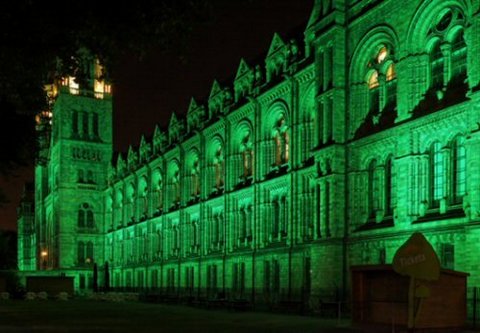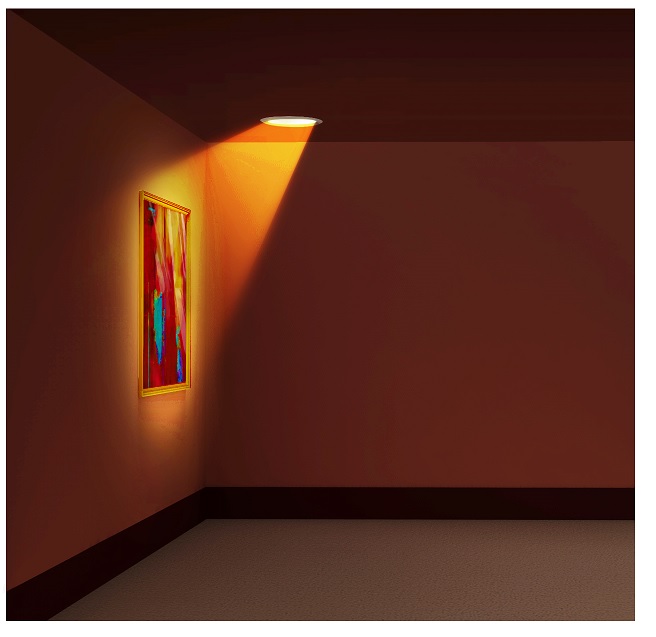Light Management Solutions for Lighting Applications
Recessed Downlights & Spotlights

Although most consumers are unaware of the role Luminit light management diffusers play in their daily lives, our products are designed into architectural and outdoor lighting fixtures around the world to homogenize a light source, control glare, flood a wall with uniform color, and even brighten a dark stairway. One size does not fit all, however, and with Luminit’s extensive library of circular and elliptical angles, selecting the right diffuser can be an intimidating task.
In Part 1 of our series on Choosing the Right Luminit Light Management Solution for Your Lighting Application, we’ll cover the different Light Shaping Diffuser® products we offer for LED recessed downlights and spotlights. Future installments will cover linear fixtures as well as outdoor and area lights. Let’s start with a quick tutorial about Light Shaping Diffusers and how the technology works.
Light Shaping Diffuser® Basics
Luminit’s diffusion technology is based on microstructures embedded on thin film, rigid or semi-rigid polycarbonate or acrylic substrates. Invisible to the naked eye are pseudo-random, non-periodic structures that are replicated from a holographically-recorded master. When exposed to a light source, the microstructures manipulate light by changing the direction of its energy. The shape of the resultant beam depends on the angle designation of the diffuser. With a fully collimated light source, a circular 30° angle will spread the beam 30° in all directions, while a 30° x 5° diffuser produces an elliptical pattern and spreads the beam 30° horizontally and 5° vertically. The larger the diffusion angle the more divergence a light ray experiences, and because Luminit diffusers use surface-relief based refraction instead of volume or bulk scatter, they tend to have a much higher transmission efficiency (~92%) than conventional diffusers.

30° Circular Beam Angle 30° × 5 Elliptical Beam Angle 60° × 1° Elliptical Beam Angle
Beam angles most commonly used by our lighting customers include 80° × 50°, 60° × 10°, 80°, 60°, 40°, 30°, 20°, 10°, and 5°; however, Luminit often creates custom angles to suit specific design requirements. In addition, extreme elliptical beam angles such as our 60° × 1° create a unique effect due to the 60 to 1 ratio (60° along the width and 1° along the length of the diffuser) and are useful for applications where the beam angle of the fixture must not increase in one axis (usually perpendicular to the wall) such as wall-wash, linear, wall-graze and cove lighting.

Light Shaping Diffusers® for Recessed Downlights & Spotlights
Light Shaping Diffusers® are often designed into LED downlights (recessed downlights) and spotlights to enhance beam quality and overcome the highly directional nature of these popular fixtures. Recessed down lights typically use a parabolic reflector or TIR optic to collimate a 120° LED source down to 10-30° (FWHM) to get the longest throw distance. However, these collimating methods introduce artifacts or imperfections that reduce uniformity and light quality. A Light Shaping Diffuser cleans up these imperfections because the microstructures act like a mixing optic. When combined with a collimating optic, the diffuser becomes a rigid window that provides precise angular beam control and widens the beam. By increasing the beam angle, larger spacing ratios are possible, and fewer fixtures can be used in any given project. This “first collimate then diffuse” approach improves light quality and saves total cost without sacrificing the optical efficiency of the luminaire, and the same fixture can address different projects and requirements.
Standard circular diffusers such as our 5°, 30° and 60° offer a small, medium, and flood distribution and are most commonly used on downlights and spots, while our 60° × 10° elliptical diffuser is often used for wall washing or hallway applications. The example below shows what can be accomplished using a 40° circular diffuser to spread the beam and cover a wider area and a 60° × 10° elliptical diffuser that highlights a specific area. Because elliptical diffusion angles diffuse more light towards one axis, this precise control of the beam angle means light is not wasted or going where it is not needed. The diffuser not only allows better beam control, it softens harsh directional light of downlights and spotlights and eliminates hotspots and striations. Typical Light Shaping Diffuser formats for recessed downlights and spotlights include rigid panels, film and injection molded.

Direction Turning Film for Recessed Downlights
Luminit Direction Turning Film (DTF) can also be integrated into recessed down lighting and applied to lights mounted in close proximity to a wall to turn directional light into volumetric room lighting. DTF imparts a 20° shift in the angle of a semi-collimated light source, allowing off-axis placement of an incoming beam when direct line of sight is impractical.
The thin film includes embedded microscopic asymmetrical prismatic structures that change the direction of a light beam without altering a fixture or aiming it after the fixture has been installed. A light beam that normally points downward and reflects off the ground, a table, counter or another surface can be redirected 20° for better visual clarity and increased illumination of artwork, pathways, stairways, etc. DTFs are also useful for in-grade lighting or recessed up-lights to direct the beam to the target wall or structure and improve illumination and coverage.

Luminit’s vast library of beam angles gives engineers and designers multiple options for improving the beam quality of recessed down lights and spotlights. In our next installment, we’ll cover how Light Shaping Diffusers, including batwing and volumetric designs, can improve linear fixtures.
Contact us at sales@luminitco.com for more information about Light Shaping Diffusers® and how our unique products can help your next project.
